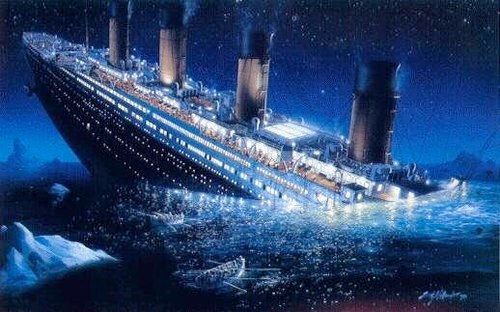
The resulting composition, Whispers on Waves, is a symphonic poem cast as an impressionistic, aural story reel.
As one scrolls, an imagined narrative unfolds: While boarding the ship, passengers hear a soundscape of harbor noises—distant motors, buoy bells, marine signals and seagulls. Soon the ship’s engines start and swirling eddies are seen in the water. As the ship gets under way the passengers feel wanderlust, wind on their faces and salt spray; they see the wash off the waves and feel the swells gently rocking them. As they move out to open water they think: everything is so beautiful . . . is this a dream?
Suddenly, their reverie is interrupted by celebratory brass band music coming from below deck. The interruption soon fades, they return to watching the wake and think: this is behind us. Not surprisingly, their wanderlust has now changed to nostalgia. Music from below deck is heard again—sounds like “dance” music . . . maybe a waltz?
They think: Oh, everything is so peaceful here—the calm sea, glints of sunshine reflecting off the water, the seagulls “talking” behind the ship . . . They return to their thoughts but now they’re so convoluted: the feelings of wanderlust, beauty, serenity, lightheartedness and nostalgia are just knotted and twisted into each other . . .
Time passes while they are lost in their thoughts, but again they think: Oh, everything is so peaceful here—the calm sea, the celestial dance of the sparkling stars, the clear, moonless night . . . But wait, isn’t it getting misty?
Soon a thick fog covers the ship and changes their world . . . hard to tell what’s real or imaginary—almost seems surrealistic. What’s happening? If they can’t be seen, can they be heard? What’s the rest of the story? Ah, fortunately in music the instruments tell the story . . .
So, the upper strings and harp set up their own electromagnetic communication field using “Hertzian waves”; the oboe sends out the Morse code “CQ” call: _. _. _ _. _ (meaning Is anyone there? or calling any station); the ‘cellos request the passengers to waltz; the upper winds continue to talk like seagulls; the trombones signal fog alerts; the ‘cellos again request everyone to waltz; the violins and violas accept; the upper winds continue to talk like seagulls; soon however, the waltz begins to break up; the lower winds and piano send out “SOS” distress signals: … _ _ _ … (popularly meaning “Save our ship” or “Save our Souls”); the horns presage an apocalyptic theme which is soon taken up by the other brass; in the confusion it seems like all fragments have become racing engines . . . Soon the inevitable collision occurs . . . The ships descend to the bottom . . .
Lying now on the seafloor, the English horn resounds the apocalyptic theme in mournful resignation; the horn and bass clarinet try to assist . . .
Only shattered fragments remain in the dark debris field: the vibraphone suggests everyone waltz again; the muted trumpets and glockenspiel retry the apocalyptic theme; the upper winds and celesta swim by as luminescent fish; the upper strings and harp offer their “Hertzian waves” once more; the muted trumpets revisit their celebratory fanfare; and the oboe still queries “Is anyone there?”
No answer will ever arrive—here only ghostly memories rise to the surface on bubbles of air to become Whispers on Waves . . .